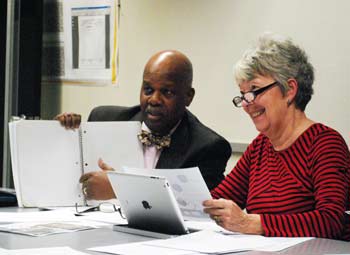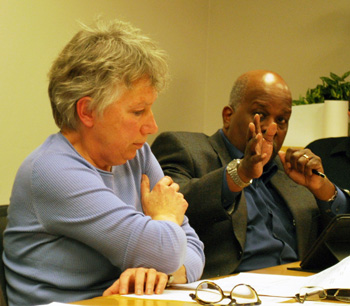A framed reproduction of “Syria by the Sea” is hung on the side of Fire Station #1, on the outside wall facing the Ann Arbor Hands On Museum entrance. [photo] It’s one of seven installations in downtown Ann Arbor, part of the Detroit Institute of Arts’ Inside|Out program program.
Stories indexed with the term ‘Detroit Institute of Art’
New Public Art Projects In the Works
Ann Arbor public art commission meeting (Jan. 23, 2013): Despite uncertainty about the future of the city’s public art program, commissioners discussed several projects at their most recent AAPAC meeting – including some new efforts that likely won’t use city funding.

From left: Ann Arbor public art commissioners Malverne Winborne and Marsha Chamberlin at AAPAC’s Jan. 23, 2013 meeting. Winborne is explaining how he had interpreted the image on a proposed sign for the Dreiseitl water sculpture – in looked like a notebook binder’s spine. (Photos by the writer.)
AAPAC chair Marsha Chamberlin described a collaboration with the city’s parks system to use old canoes for a community art project. The effort also involves the Main Street Area Association and Ann Arbor Convention & Visitors Bureau. She indicated the project would seek private donations and grants, but probably not funds from the city’s Percent for Art program, which is currently under review by the city council.
The commission also heard from Linda Tenza, a resident who came to the Jan. 23 meeting to make an informal proposal for creating murals on the ceilings of the farmers market shelter. Likening it to a Sistine Chapel effect, Tenza suggested painting food-themed murals on the ceilings of the structures that cover the market aisles. Possible themes include food as medicine, the local farm community, seasonal fruits and vegetables, and the history of farming.
Although Tenza’s project is still tentative, one public art project that’s definitely coming to Ann Arbor is the Detroit Institute of Arts’ Inside|Out program, which involves installing framed reproductions from the DIA’s collection at outdoor locations on building facades or in parks. Two private Ann Arbor businesses – Zingerman’s Deli and the downtown Borders store – were part of the program in 2010. Since then the DIA has been talking periodically with AAPAC and city staff about expanded participation.
The works will be hung from late March through June at several downtown locations, including on the facade of city hall and on the wall of the fire station that faces the Ann Arbor Hands On Museum. An official announcement about the project, including a listing of all locations, will be made at a Feb. 8 DIA press conference.
In other action at AAPAC’s Jan. 23 meeting, commissioners expressed frustration with the proposed design of a sign for the Herbert Dreiseitl water sculpture in front of city hall, calling it too “busy” with text and images that are unclear. Nor were they pleased with the proposed description of the piece that’s included on the sign: “Sculpture with Water Feature.” Chamberlin agreed to discuss their concerns with Ken Clein of Quinn Evans Architects, which handled the design.
Commissioners were also updated on several ongoing projects, including the selection of public art for the East Stadium bridges. A public engagement proposal for that $400,000 project – which might serve as a template for other projects – elicited some debate. John Kotarski objected to a recommendation that part of each artist’s interview with a selection panel should be held in private. He felt strongly that the process should be open and transparent. Wiltrud Simbuerger, who presented the recommendation, felt that the selection panel needs a “safe place” for their deliberations.
The Jan. 23 meeting included a discussion of officer elections, which AAPAC’s bylaws call for in January. The elections were ultimately postponed because only four commissioners were present at that point in the 2.5-hour meeting. Chamberlin has been serving as chair since April of 2011. Malverne Winborne is vice chair.
Also factoring into the issue of officer elections was the uncertainty of AAPAC’s future. The city council has suspended expenditures for future projects pending review of the public art program by a council committee appointed last December. Chamberlin, who has attended all meetings of that committee, gave an update to commissioners, but noted that no decisions have yet been made. The committee is expected to give its recommendations to the full council in mid-February – its next meeting is on Feb. 7. This report includes a summary of the committee’s most recent deliberations. [Full Story]
Art Commission Debates Advocacy Role
Ann Arbor public art commission meeting (Nov. 30, 2011): At their final meeting before the city council convenes on Monday night (Dec. 5) to consider changes to Ann Arbor’s Percent for Art program, public art commissioners debated how to respond – particularly to a temporary funding cut – and expressed different views on what their role should be.

Ann Arbor public art commissioners Margaret Parker and Malverne Winborne at the commission's Nov. 30 meeting. (Photo by the writer.)
Former board chair Margaret Parker, who was instrumental in creating the Percent for Art program in 2007, argued passionately that commissioners should be strong advocates for it. Saying she didn’t believe councilmembers really understood the issues that AAPAC is facing and that the currently proposed changes represented an “incredible kink in the road,” she urged commissioners to attend Monday’s city council meeting and speak against the proposed changes during the public hearing.
Parker also argued that the council should double the budget for administrative support to public art projects – from 8% to 16%.
As she’s done in the past when the proposals to cut Percent for Art funding have been floated, Parker is trying to mobilize people in the local arts community. She has sent emails urging people to lobby councilmembers, including a bullet-point “fact sheet” related to the program. [.pdf of Parker email] [.pdf of "fact sheet"]
Marsha Chamberlin, AAPAC’s current chair, questioned whether commissioners should “pick a fight” with city council, and said she felt that councilmembers did understand the issues clearly. Noting that she had attended previous council meetings and also communicated with councilmembers privately, Chamberlin wasn’t convinced that turning out yet again would be effective.
The councilmember who has in the past advised AAPAC about the sentiment on council – Tony Derezinski, who also serves on AAPAC – did not attend the Nov. 30 meeting.
Malverne Winborne pointed to political realities at play, and said that AAPAC needs to be realistic about the situation – other programs are being cut, too. If the council decides to get rid of AAPAC, he said he wouldn’t fight that. “Decommission me – what the hell,” he quipped.
In addition to an extended discussion on city council’s proposed changes to the Percent for Art ordinance, commissioners voted to move forward on two projects: (1) public art in a proposed rain garden at the corner of Kingsley and First, and (2) a partnership with the Detroit Institute of Art’s Inside|Out project, which involves installing framed reproductions from the DIA’s collection at outdoor locations on building facades or in parks.
Commissioners were also briefed on a range of other projects, including the latest on a mural at Allmendinger Park. A task force has selected four finalists for the $10,000 project: (1) Robert Delgado of Los Angeles, Calif.; (2) Bethany Kalk of Moorehead, Kentucky; (3) Jefferson Nelson of Liberty Center, Ohio; and (4) Mary Thiefels of Ann Arbor. The artists will submit preliminary concepts for potential murals on Dec. 8, and from those, the task force will recommend one for AAPAC and the city council to consider.
Commissioners also changed the date for AAPAC’s final meeting in December – to Dec. 13, when they’ll hold a follow-up discussion to their Oct. 26 working session. That October session, intended to prep AAPAC for its presentation at a Nov. 14 council work session – focused on challenges facing the Percent for Art program, and possible solutions. [Full Story]



